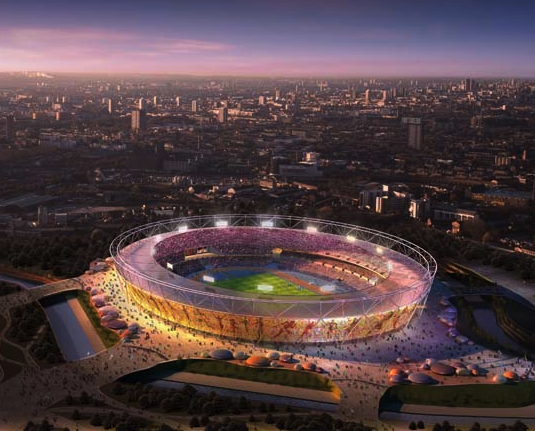As the world focuses its attention on the spectacle of the London Summer Olympic Games, we are glued to the television in awe of the athletic prowess, ceremonial majesty, and sheer enormity of this massive endeavor. However, hosting major events like the Olympics requires a huge investment of money and resources behind the scenes and often results in negative environmental impacts.

Happily, London has set a new standards for green technology and infrastructure in part by establishing a global standard for sustainable event management – ISO 20121. Organizers also developed a “food vision” program that maintains sustainable sourcing standards for the more than 14 million meals that will be served at the Games.
In a New York Times interview with David Stubbs, the head of sustainability for the London Olympic Organization Committee, Stubbs explained that significant attention has been given to the long-term legacy and role of the Olympic structures after it was predicted that the embodied carbon of construction materials would create the largest impact on the Games’ carbon footprint.
 As a result, temporary, recyclable structures were erected for venues that would not be of long-term use to the city. Additionally, the permanent venues that were constructed utilize the latest in green technology and awareness: sustainably sourced timber, recycled construction materials, lightweight roofs that save thousands of tons of steel in their design, extensive natural lighting, and even rainwater harvesting.
As a result, temporary, recyclable structures were erected for venues that would not be of long-term use to the city. Additionally, the permanent venues that were constructed utilize the latest in green technology and awareness: sustainably sourced timber, recycled construction materials, lightweight roofs that save thousands of tons of steel in their design, extensive natural lighting, and even rainwater harvesting.
Aesthetically, the stadiums appear to be the same world-class structures that we’re used to seeing at the Olympics. Most people won’t realize the enormous amount of attention London has given to its green stadiums, but the design and construction of these monuments reflect about a decade’s worth of sustainability research and thought.
This raises the bar for other events, and begs the question: how green are our stadiums here in the United States? Very few people, when attending a major entertainment or sporting event, think about how green the stadium is or what impact the event they are at will have on the environment. But they should. Stadiums are enormous structures that utilize immense amounts of energy when they put on events for thousands of individuals consuming food, paper material, and water. We don’t always think about the water required to keep fields green, or the millions of lightbulbs that go into those enormous video boards, or the fact that carbon emissions per team per game (in terms of travel, energy use, concessions, etc.) can be up to 716 tons. That’s around 17 times the amount of an average American household expends every year.
There is hope. Stadiums are becoming increasingly greener in the United States. More and more facilities are turning to energy-efficient technologies such as solar panels and wind turbines for energy, increased use of recycled materials for things ranging from construction materials to programs, and the introduction of water management systems. Some teams, such as the Philadelphia Eagles, have made incredible leaps in terms of sustainability; 100% of the power used during home games comes from wind technologies. The Natural Resources Defense Council has even put together a guide for clubs and stadium owners looking to implement the use of solar energy.
Here in New York, we’re not doing too poorly. The MetLife stadium is made of more than 40,000 tons of recycled steel, aims to cut water consumption by a quarter through the use of low-flow toilet fixtures and waterless urinals, and uses eco-friendly material for concessions. The new stadium is more than twice the size of the old stadium (in terms of square footage), yet there’s been a reduction of energy usage by almost 30%. And the total carbon footprint of games is much lower compared to other teams due to widespread use of public transit.

Stadiums can always be greener, though. Whether you’re a die-hard sports fan, or a concerned citizen, or both, it’s important that you let your home team know how important it is to you that they keep up the good work. In terms of sustainability, we’re not striking out… but we’re not hitting a home run, either.
Find out more about New York teams’ green initiatives by visiting the sustainability websites of the Yankees, the Mets, and the Giants.
Images courtesy of runnerslife.co.uk, thetechjournal.com, and eco-structure.com.